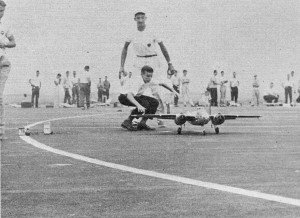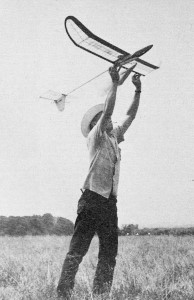|
An
extensive article introducing non-modelers to aircraft modeling
appeared in the Annual Edition of the 1962 American Modeler magazine.
15 pages were devoted to describing just about every aspect of model
building and flying - free flight gas and rubber; control line stunt,
combat, scale, and speed; helicopters and ornithopters; indoor gliders,
stick and tissue, and microfilm; even some early radio control.
In order to keep page length here reasonable (because of all
the images), the article is broken into a few pages. Pages:
|
10 & 11 |
12|
13 |
14 |
15 |16
|
17 |
18 |
19 |
20 |
21 |
22 |23
|
24 | For Non-Modelers: All About Air Modeling
20 Easy Ways to Go Crazy! <previous> <next>

Something to keep you busy nights would be a project like this
giant B-25 Ukie. All its systems worked, too! Maybe after you
completed it, you'd then sit up nights worrying about the test-hop.

More peaceful is towline glider category ... Nordic class entry
is being released by "mechanic."
Flying is done on 60 ft. lines, three to six models compete in a
race. Races are divided into three heats: 35 laps, no required reo
fueling stop; 70 laps, one mandatory refueling stop; 140 laps, two
mandatory refueling stops. First team completing required laps in
heat or race is winner. A point system is used to score winners
of 35 and 70 laps events for entry into 140 lap feature.
Flying team cooperation is a big factor in achieving winning
performance. One flyer and no more than two crew members comprise
a team. The pit crew can make or break a winning flight by the speed
with which they re-fuel and re-start the engine during the long
lap features. C/L TEAM RACING - Grand-daddy
of Rat Racing is Team Racing. The events are similar in some respects-35,
70 and 140 laps races being flown. There are also 7 lap qualification
flights, 21 lap heats and 100 lap consolation races. This schedule
has been copied directly from full scale airplane racing. Starts
are made with all models released at once from mechanical "stooges"
fastened to flying site surface. In Rat Racing takeoff release is
done by hand by a crew member. Team Racing model requirements
are more detailed than for Rat Racing. Engine limits are similar,
.15 to .30 cu. in.; engines must be completely cowled; minimum wing
area is 125 sq. in.; maximum fuel capacity 1 ounce. In addition,
models must be semi-scale and resemble real racing airplanes. Cockpit
must contain a dummy pilot's head and fuselage cross-section must
be of specified dimensions. landing gear can be fixed or retractable.
Tail skid must have loop at end to fit take-off stooge. Models must
be colorfully painted and have large numbers on. fuselage. In some
competitions, models are judged .for beauty and workmanship, bonus
points being added to flying score. Team racing is the nearest
thing in modeling to the exciting National Air Race Goodyear and
Thompson classics of the past. There is action aplenty! When all
engines are started and running, crew leaves the circle rim, then
when the green flag drops all models are released at once. Take
off can be hectic with grand tangles sometimes occurring. Once airborne,
models pass and jockey for position as the laps pile up. There is
plenty of action among the pilots and many team race fans watch
the mad dance in the center of the circle rather than the models
in the air. This wild type of model flying grew out of team
racing and stunt. The mortality rate of engines and models here
is higher than in any other contest event. This is strictly for
the "Dive and zoom-go get 'em, Tiger" modelers. Crepe paper streamers
8 ft. long are tied to the tail of each model. The object is to
get on the other flyer's tail and cut the streamer with your propeller.
Scoring is done by piling up the greatest number of "cuts" and "kills"
during' a five minute flight period. "Cuts" are scored if paper
streamer is cut and "kills" are scored if 30" string leader between
model and streamer is cut. A "kill" ends scoring and "cut" and "kill"
scores are totaled to determine winner and establish his standing
in subsequent elimination rounds. Combat contestant matching is
usually done by drawing lots, but order of entry or previous elimination
scoring is sometimes used to pair off the "fighters." Combat
flying can get real crazy, and a "kill" often means a collision
- ho hum, back to the workbench. Inverted flying was once permitted
(not under present rules) and dandy games of "chicken" and head-on
bust-ups occurred with one model circling one way meeting the other
model coming from the opposite direction. For this kind
of nutty flying, construction is "quick and dirty." No wasted motion
on fancy finish. Just the bare minimum that will fly fast, turn
on a dime and carry a tank and engine. Short-coupled
stunt models are used for combat because of their maneuverability.
Favorite types are profile stunt trainers and the simpler all-wing
designs. Maximum engine size permitted is .36 cu. in. Flying lines
are 60 ft. in length. Models are usually about 36" wing span. Since
balsa stock is cut to this length replacement or duplicate parts
are easily made. C/L NAVY CARRIER - This
highly challenging event puts a premium on flying skill and requires
considerable gadgetry in the model itself. The object of the event
is to simulate the performance of real carrier-based aircraft. The
model must take off from a limited deck space, fly at high speed,
fly at low speed, then make a landing into an arresting gear on
the model carrier's deck. Competition is sponsored by the U. S.
Navy and is usually run off only at the major national contests.
However, some modelers enjoy carrier flying with their own simplified
versions of the U.S.S. Smallfry, set up for club flying and smaller
contests.
Model
carrier deck is 44 ft. long and 8 ft. wide. Its center line is curved
to the perimeter of a 60 ft. radius flying circle. The deck is built
of plywood panels with suitable framing underneath and is raised
about 6" to 12" above the ground. All flying must be done off the
deck and all ground area is considered "water." If model touches
the "water" during flight it is considered to have crashed, ending
the flight. The deck is divided into two sections, fore
and aft. Forward section, a free-roll area for take-offs, is 24
ft. long. After part is arresting area, 20 ft. long, and has arresting
gear across deck spaced 2 ft. apart. Arresting gear lines are suspended
1" to 11h" above deck. The gear is stout cord 18 ft. long and passes
through guides at deck edges. Gear cord has 4 to 5 lb. sandbags
attached at each end alongside deck edge. When model is landed on
the deck, its arresting hook snags a line and weight of sandbags
slow model quickly. This arresting gear is a miniature duplicate
of actual early U. S. Navy deck landing experiments conducted in
1911. So much for the carrier deck. What kind of a model
is flown off a miniature flat top? Complicated? Yes, to a certain
extent. First, some sort of engine throttle must be used so that
model can be flown at both high and low speeds. Engines with exhaust
restrictors or intake chokes designed for radio control flying are
well suited for use with carrier models, Throttle control systems
operating from the flyers control handle are needed for high and
low speed flying. J. Roberts Flight Control bellcrank and handle
and Vari-speed throttle are specifically designed for this.
<previous> <next>
Posted December 25, 2010
|